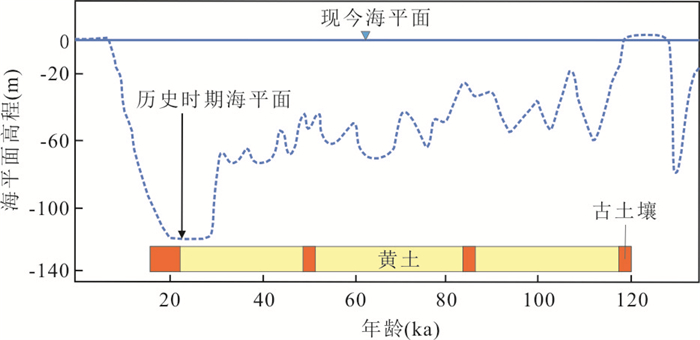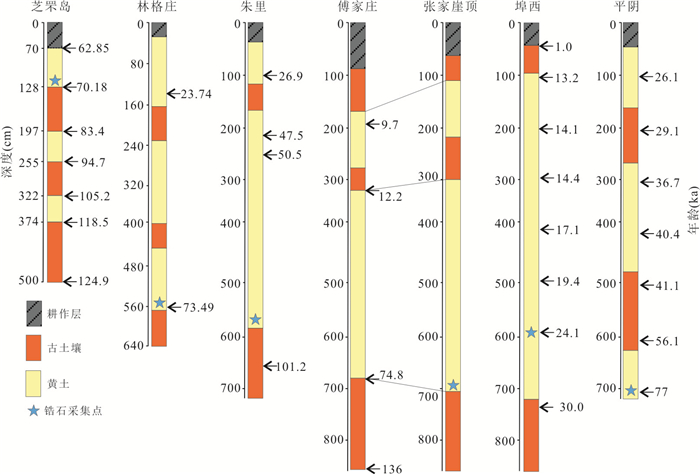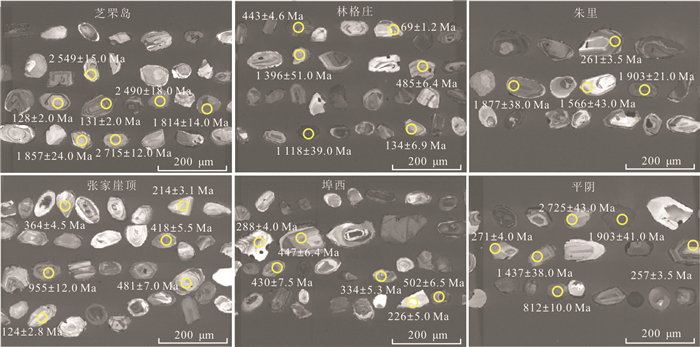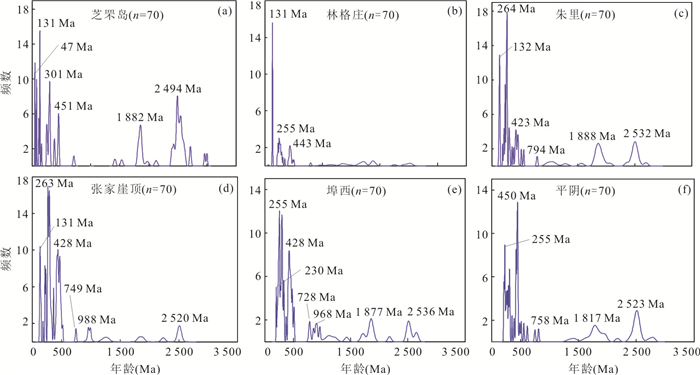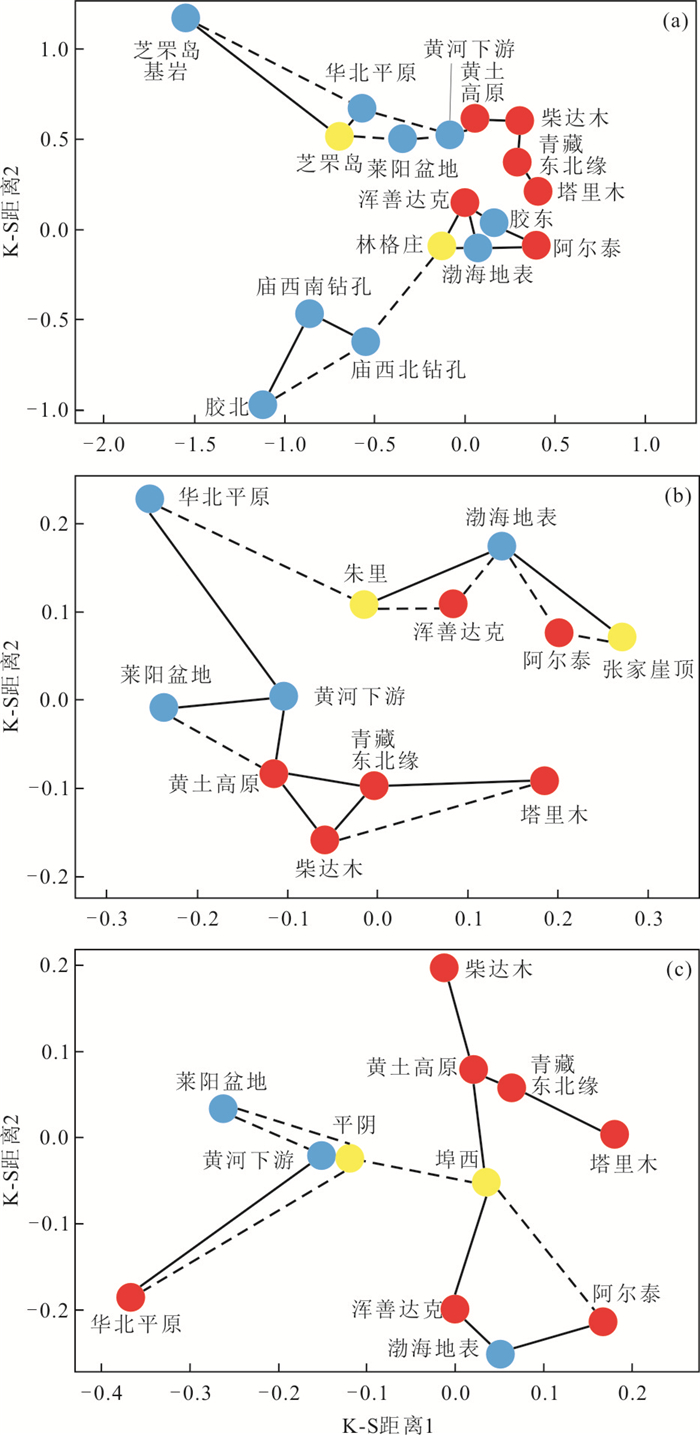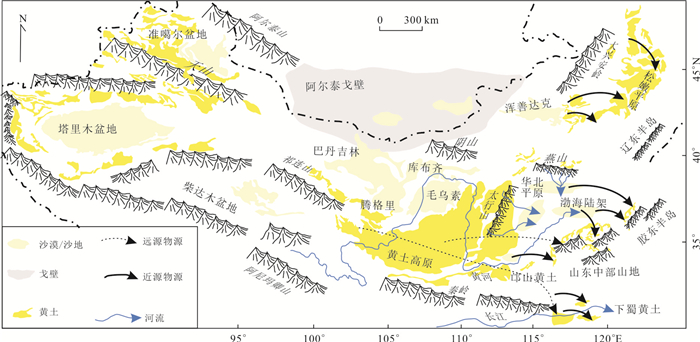Provenance of the Loess in Shandong Province (Eastern China) during the Last Ice Age: Constraints from the U-Pb Age of Detrital Zircons
-
摘要: 胶东半岛北部海滨和山东中部山区北麓沉积了典型的风尘黄土,详细记录了晚更新世以来的气候变化,然而有关这些黄土究竟来自哪里,目前仍处于争议之中.锆石是黄土中常见的副矿物,其U-Pb年龄谱对比被广泛用于黄土的物源示踪研究.基于此,利用激光剥蚀电感耦合等离子质谱仪(LA-ICP-MS)对上述地区晚更新世典型的黄土剖面开展碎屑锆石(n=420)微区原位U-Pb年龄分析,结合Kolmogorov-Smirnov统计方法的多维判别图和前人已经发表的研究结果,发现胶东半岛北部海岸和山东中部山地北麓东段的晚更新世黄土主要来自渤海裸露的大陆架和华北平原的碎屑物质,受中国西北内陆干旱区的影响较小,但由于地理位置的差异,山东中部山地北麓西段的晚更新世黄土具有黄河下游和黄土高原的物质信号,而与晚更新世渤海末次冰期裸露在海底的沉积物的物源关系较弱.Abstract: The thick loess-palaeosol sequences in the Jiaodong Peninsula and Central Shandong mountains provide high-resolution records of Late Quaternary climate change of the Shandong Province. However, it is still controversial as to where they came from. This study presents systematically the detrital zircon U-Pb age (n=420) and multi-dimensional discrimination diagram results of statistical method. It is shown that the North China Plain and Bohai shelf material served as a major dust supply for the loess in the Jiaodong Peninsula and eastern parts of the Central Shandong mountains during the Late Pleistocene. By contrast, the major dust source for the loess in the western parts of the Central Shandong mountains is mainly derived from the sediments exposed on the floodplain of the lower reaches of the Yellow River and the Loess Plateau during the Late Pleistocene. They have no provenance relationship with the sediments exposed on the sea floor in the Bohai Sea at the same time.
-
Key words:
- Jiaodong Peninsula /
- Central Shandong Mountains /
- loess /
- zircon U-Pb age /
- Quaternary /
- stratigraphy
-
图 1 中国主要沙漠、戈壁和黄土位置分布(a),山东黄土位置分布(b)
底图a修改自Sun et al.(2008)、Nie et al.(2014)和Li et al.(2020b),图中数字1~7(1:Xie and Ding, 2007,Rittner et al., 2016;2:Pullen et al., 2011;3:Zhang et al., 2016;4:Stevens et al., 2010, Nie et al., 2014;5:Gong et al., 2017;6:Xiong et al.,2021;7:Stevens et al., 2010)代表沙漠、戈壁、黄土碎屑锆石采集地,8~11(8:林旭等,2020;9:Yang et al., 2009;10:Yang et al., 2009, Nie et al., 2015;11:Nie et al., 2015)为华北克拉通河流碎屑锆石采样位置;图b中1~3为渤海钻孔锆石数据(1和2:Huang et al., 2020;3:Sun et al., 2020),a~f为渤海钻孔气候数据(Yao et al., 2014, 岳保静等,2020)
Fig. 1. Location distribution of major deserts, gobi and loess in China (a); distribution diagram of loess locations in Shandong Province (b)
图 2 晚更新世以来黄海及其邻近地区海平面变化曲线
图修改自赵希涛等(1979)、岳保静等(2020)
Fig. 2. Curve of sea-level changes of Yellow Sea and adjacent areas since 120 ka
图 3 晚更新世山东黄土及其年龄分布柱状图
芝罘岛结果据黎武标等(2019a);林格庄结果据徐树建和王涛(2011);朱里结果据李强(2014);傅家庄结果据彭淑贞等(2010);埠西结果据徐树建等(2014);平阴结果据徐树建等(2016).张家崖顶剖面采样点年龄通过与其邻近傅家庄剖面进行对比,限定在晚更新世
Fig. 3. Histogram of Shangdong loess in the Late Pleistocene and its age distribution.
图 7 山东黄土和潜在物源区的锆石U-Pb年龄频率分布
a、d、h、j、l、n.本次研究;b. Liu et al.(2013);c. Sun et al.(2020);e. 张田和张岳桥(2008);f. Huang et al.(2020);g. Zhang et al.(2019);i、k、m、o.林旭未发表数据;p. Yang et al.(2009)、Nie et al.(2015);q. Yang et al.(2009)、林旭等(2020);r. Xie and Ding(2007)、Rittner et al.(2016);s. Stevens et al.(2010);t. Zhang et al.(2016);u. Stevens et al.(2010);Nie et al.(2014)、Gong et al.(2017)、Xiong et al.(2021);v. Zhang et al.(2016);w. Pullen et al.(2011). 图中黄色、蓝色和红色分别代表黄土剖面、近源区、远源区
Fig. 7. U-Pb age frequency distribution of zircons from the loess and potential provenance regions of the Shandong Province
-
Bird, A., Stevens, T., Rittner, M., et al., 2015. Quaternary Dust Source Variation across the Chinese Loess Plateau. Palaeogeography, Palaeoclimatology, Palaeoecology, 435: 254-264. https://doi.org/10.1016/j.palaeo.2015.06.024 Cao, J. X., Li, P. Y., Shi, N., 1987. Loess of Miaodao Islands in Shandong Province. Science in China (Series B), 17 (10): 1116-1123 (in Chinese with Englisha abstract). Cao, J. X., Yan, R. E., Wang, H., 1994. Red Weathering Crusts and Brown Red Earth and Their Paleoclimatic Significance in Shandong Miaodao IsIands. Science in China (Series B), 24(2): 216-224 (in Chinese with Englisha abstract). http://www.researchgate.net/publication/345880037_shandongmiaodaoqundaodehongsefenghuakeyuzonghongtujiqiguqihouyiyi Che, X. D., Li, G. J., 2013. Binary Sources of Loess on the Chinese Loess Plateau Revealed by U-Pb Ages of Zircon. Quaternary Research, 80(3): 545-551. https://doi.org/10.1016/j.yqres.2013.05.007 Chen, J., Li, G. J., Yang, J. D., et al., 2007. Nd and Sr Isotopic Characteristics of Chinese Deserts: Implications for the Provenances of Asian Dust. Geochimica et Cosmochimica Acta, 71(15): 3904-3914. https://doi.org/10.1016/j.gca.2007.04.033 Ding, M., Peng, S. Z., Mao, L. J., et al., 2017. Major Element Geochemistry of LongShan Loess Profile in the Central Shandong Mountainous Regions, Northern China. Journal of Risk Analysis and Crisis Response, 7(3): 127. https://doi.org/10.2991/jrarc.2017.7.3.3 Ding, M., Zhang, J. X., Peng, S. Z., et al., 2018. Geochemical and Clay-Size Minerals Evidence for the Provenance of LQC Loess Deposits in the Central Shandong, Northern China. Journal of Risk Analysis and Crisis Response, 8(1): 24-34. https://doi.org/10.2991/jrarc.2018.8.1.3 Ding, X. C., 2016. Comparison of Sedimentary Characteristics between Buxi Loess Profile and Tuoji II Loess Profile in Shandong Province (Dissertation). Shandong Normal University, Jinan (in Chinese with English abstract). Ding, X. C., Cao, W., Xu, S. J., et al., 2015. Characteristics of Rare Earth Elements in Pingyin Loess Profile, Shandong Province and Its Implications for Provenance. Journal of Arid Land Resources and Environment, 29(9): 188-192 (in Chinese with English abstract). http://en.cnki.com.cn/Article_en/CJFDTOTAL-GHZH201509033.htm Ding, Z. L., Sun, J. M., Rutter, N. W., et al., 1999. Changes in Sand Content of Loess Deposits along a North-South Transect of the Chinese Loess Plateau and the Implications for Desert Variations. Quaternary Research, 52(1): 56-62. https://doi.org/10.1006/qres.1999.2045 Fan, Y. X., Mou, X. S., Wang, Y. D., et al., 2018. Quaternary Paleoenvironmental Evolution of the Tengger Desert and Its Implications for the Provenance of the Loess of the Chinese Loess Plateau. Quaternary Science Reviews, 197: 21-34. https://doi.org/10.1016/j.quascirev.2018.08.002 Fu, X. H., 2014. Geochemical Characteristics of Pingyin Loess and Its Provenance in Shandong Province (Dissertation). Shandong Normal University, Jinan (in Chinese with English abstract). Gong, H. J., Xie, W. B., Zhang, R., et al., 2017. U-Pb Ages of Detrital Zircon and Provenances of Red Clay in the Chinese Loess Plateau. Journal of Asian Earth Sciences, 138: 495-501. https://doi.org/10.1016/j.jseaes.2017.02.014 Huang, X. T., Song, J. Z., Yue, W., et al., 2020. Detrital Zircon U-Pb Ages in the East China Seas: Implications for Provenance Analysis and Sediment Budgeting. Minerals, 10(5): 398. https://doi.org/10.3390/min10050398 Kang, C. G., Chang, Z., Cai, C. M., et al., 2013. Heavy Mineral Characteristics of the Loess Deposits in the Eastern Songnen Plain: Implication for Sediment Provenance. Advanced Materials Research, 726-731: 4081-4085. https://doi.org/10.4028/www.scientific.net/amr.726-731.4081 Li, G. J., Li, L., Xu, S. J., et al., Dust Source of the Loess Deposits in the Eastern China Constrained by Uranium Comminution Age. Quaternary Research, 37(5): 1037-1044 (in Chinese with English abstract). Li, L., Ni, J. R., Chang, F., et al., 2020a. Global Trends in Water and Sediment Fluxes of the World's Large Rivers. Science Bulletin, 65(1): 62-69. https://doi.org/10.1016/j.scib.2019.09.012 Li, Q., 2014. Loess Chronology and Environmental Significance of Weifang Zhuli Profile in Shandong Province (Dissertation). Shandong Normal University, Jinan (in Chinese with English abstract). Li, S. Z., Zhao, G. C., Dai, L. M., et al., 2012. Cenozoic Faulting of the Bohai Bay Basin and Its Bearing on the Destruction of the Eastern North China Craton. Journal of Asian Earth Sciences, 47: 80-93. https://doi.org/10.1016/j.jseaes.2011.06.011 Li, W. B., Li, Z. W., Wang, Z. G., et al., 2019a. Climatic Environment Changes during the last Interglacial-Glacial Cycle in Zhifu Loess Section: Revealed by Grain-Size End-Member Algorithm. Marine Geology & Quaternary Geology, 39(2): 177-187 (in Chinese with English abstract). http://en.cnki.com.cn/Article_en/CJFDTotal-HYDZ201902017.htm Li, W. B., Li, Z. W., Wang, Z. G., et al., 2019b. Fractal Characteristics of Grain Size from Zhifu Section in Yantai Area of Shandong, China and Their Environmental Significance. Journal of Earch Sciences and Environment, 41(5): 592-603 (in Chinese with English abstract). Li, Y. R., Shi, W. H., Aydin, A., et al., 2020b. Loess Genesis and Worldwide Distribution. Earth-Science Reviews, 201: 102947. https://doi.org/10.1016/j.earscirev.2019.102947 Lin, X., Liu, J., Wu, Z. H., et al., 2020. Detrital Zircon U-Pb Ages and K-Feldspar Main and Trace Elements Provenance Studying from Fluvial to Marine Sediments in Northern China. Acta Geologica Sinica, 94(10): 3024-3035 (in Chinese with English abstract). http://www.researchgate.net/publication/343917750_Detrital_zircon_U-_Pb_ages_and_K-_feldspar_main_and_trace_elements_provenance_studying_from_fluvial_to_marine_sediments_in_northern_China Lin, X., Liu, J., Wu, Z. H., et al., 2021. Study on Borehole Provenance Tracing and Fluvial Sediment Diffusion in the Bohai Sea: Double Constraints from Detrital Zircon U-Pb Age and In-Situ Geochemical Element of Apatite Grains. Journal of Geomechanics, 27(2): 304-316 (in Chinese with English abstract). Liu, J. H., Liu, F. L., Ding, Z. J., et al., 2013. U-Pb Dating and Hf Isotope Study of Detrital Zircons from the Zhifu Group, Jiaobei Terrane, North China Craton: Provenance and Implications for Precambrian Crustal Growth and Recycling. Precambrian Research, 235: 230-250. https://doi.org/10.1016/j.precamres.2013.06.014 Liu, L. J., Li, P. Y., Wang, Y. J., 2000. The grain-Size Properties and Genesis of the Loess in Central Shandong Province. Marine Geology & Quaternary Geology, 20(1): 81-86 (in Chinese with English abstract). http://en.cnki.com.cn/Article_en/CJFDTOTAL-HYDZ200001017.htm Liu, X. X., Sun, Y. B., Vandenberghe, J., et al., 2018. Palaeoenvironmental Implication of Grain-Size Compositions of Terrace Deposits on the Western Chinese Loess Plateau. Aeolian Research, 32: 202-209. https://doi.org/10.1016/j.aeolia.2018.03.008 Lu, H. Y., Wang, X. Y., Wang, X. Y., et al., 2019. Formation and Evolution of Gobi Desert in Central and Eastern Asia. Earth-Science Reviews, 194: 251-263. https://doi.org/10.1016/j.earscirev.2019.04.014 Milliman, J. D., Farnsworth, K. L., 2013. River Discharge to the Coastal Ocean: A Global Synthesis. Cambridge University Press, Cambridge. Ni, Z. C., 2015. Optically Stimulated Luminescence Dating and the Provenance Analysis of Loess in Miaodao Islands, Shandong Province (Dissertation). Shandong Normal University, Jinan (in Chinese with English abstract). Nie, J. S., Peng, W. B., Möller, A., et al., 2014. Provenance of the Upper Miocene-Pliocene Red Clay Deposits of the Chinese Loess Plateau. Earth and Planetary Science Letters, 407: 35-47. https://doi.org/10.1016/j.epsl.2014.09.026 Nie, J. S., Stevens, T., Rittner, M., et al., 2015. Loess Plateau Storage of Northeastern Tibetan Plateau-Derived Yellow River Sediment. Nature Communications, 6(1): 1-10. https://doi.org/10.1038/ncomms9511 Niu, H. Y., Jin, B. F., Liu, C. N., et al., 2009. Origin of Loess-Like Loess in Zhifu Island on Mineralogic View and Paleoclimatic Change. Global Geology, 28(4): 476-484 (in Chinese with English abstract). http://epub.cnki.net/grid2008/docdown/docdownload.aspx?filename=SJDZ200904011&dbcode=CJFD&year=2009&dflag=pdfdown Niu, H. Y., Jin, B. F., Liu, C. N., et al., 2010. Sedimentary Characteristics and Provenance Analysis of Loess in the Zhifu Island, Shandong, China. Marine Geology & Quaternary Geology, 30(1): 115-123 (in Chinese with English abstract). http://adsabs.harvard.edu/abs/2010MGQG...30..115N Pan, F., Li, J. X., Xu, Y., et al., 2016. Provenance of Neogene Eolian Red Clay in the Altun Region of Western China-Insights from U-Pb Detrital Zircon Age Data. Palaeogeography, Palaeoclimatology, Palaeoecology, 459: 488-494. https://doi.org/10.1016/j.palaeo.2016.07.020 Paton, C., Woodhead, J. D., Hellstrom, J. C., et al., 2010. Improved Laser Ablation U-Pb Zircon Geochronology through Robust Downhole Fractionation Correction. Geochemistry, Geophysics, Geosystems, 11(3): Q0AA06. https://doi.org/10.1029/2009gc002618 Peng, S. Z., Gao, Z. D., Wu, X. P., et al., 2007. Grain-Size Distribution and Genesis of Loess in the Qingzhou Area, Shandong. Journal of Geomechanics, 13(4): 315-321 (in Chinese with English abstract). http://www.researchgate.net/publication/303197330_Grain-size_distribution_and_genesis_of_loess_in_the_Qingzhou_area_Shandong Peng, S. Z., Hao, Q. Z., Wang, L., et al., 2016. Geochemical and Grain-Size Evidence for the Provenance of Loess Deposits in the Central Shandong Mountains Region, Northern China. Quaternary Research, 85(2): 290-298. https://doi.org/10.1016/j.yqres.2016.01.005 Peng, S. Z., Zhu, L. J., Xiao, G. Q., et al., 2010. Magnetostratigraphy and Provenance of the Qingzhou Loess in Shandong Province. Arid Land Geography, 33(6): 947-953 (in Chinese with English abstract). Peng, S. Z., Zhu, L. J., Xiao, G. Q., et al., 2011. Magnetostratigraphy and Provenance of the Qingzhou Loess in Shandong Province. Journal of Arid Land, 3(3): 184-190. https://doi.org/10.3724/SP.J.1227.2011.00184 Pullen, A., Kapp, P., McCallister, A. T., et al., 2011. Qaidam Basin and Northern Tibetan Plateau as Dust Sources for the Chinese Loess Plateau and Paleoclimatic Implications. Geology, 39(11): 1031-1034. https://doi.org/10.1130/g32296.1 Rittner, M., Vermeesch, P., Carter, A., et al., 2016. The Provenance of Taklamakan Desert Sand. Earth and Planetary Science Letters, 437: 127-137. https://doi.org/10.1016/j.epsl.2015.12.036 Shang, Y., Prins, M. A., Beets, C. J., et al., 2018. Aeolian Dust Supply from the Yellow River Floodplain to the Pleistocene Loess Deposits of the Mangshan Plateau, Central China: Evidence from Zircon U-Pb Age Spectra. Quaternary Science Reviews, 182: 131-143. https://doi.org/10.1016/j.quascirev.2018.01.001 Song, M. C., Yu, X. S., Song, Y. X., et al., 2020. Types, Sources, and Regional Crust-Mantle Evolution Background of Diamonds in the Western Shandong Province. Acta Geologica Sinica, 94(9): 2606-2625 (in Chinese with English abstract). Stevens, T., Palk, C., Carter, A., et al., 2010. Assessing the Provenance of Loess and Desert Sediments in Northern China Using U-Pb Dating and Morphology of Detrital Zircons. Geological Society of America Bulletin, 122(7-8): 1331-1344. https://doi.org/10.1130/b30102.1 Sun, J. M., 2002. Provenance of Loess Material and Formation of Loess Deposits on the Chinese Loess Plateau. Earth and Planetary Science Letters, 203(3-4): 845-859. https://doi.org/10.1016/S0012-821X(02)00921-4 Sun, Y. B., Tada, R., Chen, J., et al., 2007. Distinguishing the Sources of Asian Dust Based on Electron Spin Resonance Signal Intensity and Crystallinity of Quartz. Atmospheric Environment, 41(38): 8537-8548. https://doi.org/10.1016/j.atmosenv.2007.07.014 Sun, Y. B., Tada, R., Chen, J., et al., 2008. Tracing the Provenance of Fine-Grained Dust Deposited on the Central Chinese Loess Plateau. Geophysical Research Letters, 35(1): L01804. https://doi.org/10.1029/2007gl031672 Sun, Z. H., Zhu, H. T., Xu, C. G., et al., 2020. Reconstructing Provenance Interaction of Multiple Sediment Sources in Continental Down-Warped Lacustrine Basins: An Example from the Bodong Area, Bohai Bay Basin, China. Marine and Petroleum Geology, 113: 104142. https://doi.org/10.1016/j.marpetgeo.2019.104142 Tang, J., Zheng, Y. F., Wu, Y. B., et al., 2008. Zircon U-Pb Age and Geochemical Constraints on the Tectonic Affinity of the Jiaodong Terrane in the Sulu Orogen, China. Precambrian Research, 161(3-4): 389-418. https://doi.org/10.1016/j.precamres.2007.09.008 Thompson, J. M., Meffre, S., Danyushevsky, L., 2018. Impact of Air, Laser Pulse Width and Fluence on U-Pb Dating of Zircons by LA-ICPMS. Journal of Analytical Atomic Spectrometry, 33(2): 221-230. https://doi.org/10.1039/C7JA00357A Tian, S. C., Sun, J. M., Lü, L., et al., 2019. Optically Stimulated Luminescence Dating of Late Quaternary Loess Deposits in the Coastal Region of North China: Provenance and Paleoclimatic Implications. Quaternary Science Reviews, 218: 160-177. https://doi.org/10.1016/j.quascirev.2019.06.022 Vermeesch, P., Resentini, A., Garzanti, E., 2016. An R Package for Statistical Provenance Analysis. Sedimentary Geology, 336: 14-25. https://doi.org/10.1016/j.sedgeo.2016.01.009 Wan, Y. S., Wang, S. J., Liu, D. Y., et al., 2012. Redefinition of Depositional Ages of Neoarchean Supracrustal Rocks in Western Shandong Province, China: SHRIMP U-Pb Zircon Dating. Gondwana Research, 21(4): 768-784. https://doi.org/10.1016/j.gr.2011.05.017 Wang, B., Zheng, H. B., He, Z., et al., 2014. Middle Miocene Eolian Sediments on the Southern Chinese Loess Plateau Dated by Magnetostratigraphy. Palaeogeography, Palaeoclimatology, Palaeoecology, 411: 257-266. https://doi.org/10.1016/j.palaeo.2014.07.007 Wang, X., Dettman, D. L., Wang, M., et al., 2020. Seasonal Wet-Dry Variability of the Asian Monsoon since the Middle Pleistocene. Quaternary Science Reviews, 247: 106568. https://doi.org/10.1016/j.quascirev.2020.106568 Wang, X., Wei, H., Taheri, M., et al., 2016. Early Pleistocene Climate in Western Arid Central Asia Inferred from Loess-Palaeosol Sequences. Scientific Reports, 6(1): 20560. https://doi.org/10.1038/srep20560 Wang, X. Y., Lu, H. Y., Zhang, H. Z., et al., 2018. Distribution, Provenance, and Onset of the Xiashu Loess in Southeast China with Paleoclimatic Implications. Journal of Asian Earth Sciences, 155: 180-187. https://doi.org/10.1016/j.jseaes.2017.11.022 Wang, Y. N., 2013. The Provenance of Loess in North Slope of Shandong Central Mountain Area and Its Environmental Implication (Dissertation). Shanxi Normal University, Linfen (in Chinese with English abstract). Xiao, G. Q., Zong, K. Q., Li, G. J., et al., 2012. Spatial and Glacial-Interglacial Variations in Provenance of the Chinese Loess Plateau. Geophysical Research Letters, 39(20): L20715. https://doi.org/10.1029/2012gl053304 Xie, J., Ding, Z. L., 2007. Compositions of Heavy Minerals in Northeastern China Sandlands and Provenance Analysis. Science China Earth Sciences, 50(11): 1715-1723. https://doi.org/10.1007/s11430-007-0110-0 Xie, J., Yang, S. L., Ding, Z. L., 2012. Methods and Application of Using Detrital Zircons to Trace the Provenance of Loess. Science China Earth Sciences, 55(11): 1837-1846. https://doi.org/10.1007/s11430-012-4428-x Xie, Y. Y., Kang, C. G., Chi, Y. P., et al., 2019. The Loess Deposits in Northeast China: The Linkage of Loess Accumulation and Geomorphic-Climatic Features at the Easternmost Edge of the Eurasian Loess Belt. Journal of Asian Earth Sciences, 181: 103914. https://doi.org/10.1016/j.jseaes.2019.103914 Xiong, J. G., Zhang, H. P., Zhao, X. D., et al., 2021. Origin of the Youngest Cenozoic Aeolian Deposits in the Southeastern Chinese Loess Plateau. Palaeogeography, Palaeoclimatology, Palaeoecology, 561: 110080. https://doi.org/10.1016/j.palaeo.2020.110080 Xu, J. G., Zhang, T., Xu, H., et al., 2019. Study on Coastal Loess in the Laizhou Bay. Advances in Marine Science, 37(1): 43-54 (in Chinese with English abstract). http://en.cnki.com.cn/Article_en/CJFDTotal-HBHH201901005.htm Xu, Q. M., Yuan, G. B., Yang, J. L., et al., 2017. Plio-Pleistocene Magnetostratigraphy of Northern Bohai Bay and Its Implications for Tectonic Events since Ca. 2.0 Ma. Journal of Geodynamics, 111: 1-14. https://doi.org/10.1016/j.jog.2017.08.002 Xu, S. J., Ding, X. C., Ni, Z. C., 2014. The Sedimentary Characteristics of Buxi Loess Profile in Shandong Province and Their Paleoclimatic and Palaeoenvironment Significance. Acta Geographica Sinica, 69(11): 1707-1717 (in Chinese with English abstract) http://www.cnki.com.cn/Article/CJFDTotal-DLXB201411013.htm Xu, S. J., Ding, X. C., Yu, L. P., et al., 2015. Palaeoclimatic Implications of Aeolian Sediments on the Miaodao Islands, Bohai Sea, East China, Based on OSL Dating and Proxies. Aeolian Research, 19: 259-266. https://doi.org/10.1016/j.aeolia.2015.02.001 Xu, S. J., Kong, F. B., Jia, G. J., et al., 2018. An Integrated OSL Chronology, Sedimentology and Geochemical Approach to Loess Deposits from Tuoji Island, Shandong Province: Implications for the Late Quaternary Paleoenvironment in East China. Aeolian Research, 31: 105-116. https://doi.org/10.1016/j.aeolia.2017.07.007 Xu, S. J., Ni, Z. C., Ding, X. C., 2016. Geochemical Characteristics of Major Elements of the Pingyin Loess in Shandong Province. Bulletin of Mineralogy, Petrology and Geochemistry, 35(2): 353-359 (in Chinese with English abstract). http://en.cnki.com.cn/Article_en/CJFDTOTAL-KYDH201602023.htm Xu, S. J., Wang, T., 2011. Optically Stimulated Luminescence Dating and Sedimentary Characteristics of Loess Section at Penglai in Shandong Province. Journal of Desert Research, 31(2): 295-301 (in Chinese with English abstract). Yang, J., Gao, S., Chen, C., et al., 2009. Episodic Crustal Growth of North China as Revealed by U-Pb Age and Hf Isotopes of Detrital Zircons from Modern Rivers. Geochimica et Cosmochimica Acta, 73(9): 2660-2673. https://doi.org/10.1016/j.gca.2009.02.007 Yang, Q. Y., Santosh, M., Shen, J. F., et al., 2014. Juvenile vs. Recycled Crust in NE China: Zircon U-Pb Geochronology, Hf Isotope and an Integrated Model for Mesozoic Gold Mineralization in the Jiaodong Peninsula. Gondwana Research, 25(4): 1445-1468. https://doi.org/10.1016/j.gr.2013.06.003 Yao, Z. Q., Guo, Z. T., Xiao, G. Q., et al., 2012. Sedimentary History of the Western Bohai Coastal Plain since the Late Pliocene: Implications on Tectonic, Climatic and Sea-Level Changes. Journal of Asian Earth Sciences, 54-55: 192-202. https://doi.org/10.1016/j.jseaes.2012.04.013 Yao, Z. Q., Shi, X. F., Liu, Q. S., et al., 2014. Paleomagnetic and Astronomical Dating of Sediment Core BH08 from the Bohai Sea, China: Implications for Glacial-Interglacial Sedimentation. Palaeogeography, Palaeoclimatology, Palaeoecology, 393: 90-101. https://doi.org/10.1016/j.palaeo.2013.11.012 Yi, L., Deng, C., Tian, L., et al., 2016. Plio-Pleistocene Evolution of Bohai Basin (East Asia): Demise of Bohai Paleolake and Transition to Marine Environment. Scientific Reports, 6: 29403. https://doi.org/10.1038/srep29403 Yue, B. J., Liu, J. Q., Liu, J., et al., 2020. Grain Size Distribution of Sediment of Core YRD-1101 in the Western Margin of the Modern Bohai Sea since the Latest Pleistocene and Its Environmental Change. Geology in China, 47(3): 853-867 (in Chinese with English abstract). Zeng, F. M., Xiang, S. Y., Liu, X. J., et al., 2014. Progress in Tracing Provenance of Eolian Deposits in Chinese Loess Plateau. Earth Science, 39(2): 125-140 (in Chinese with English abstract). Zhang, B., Liu, S. F., Lin, C. F., et al., 2019. Source-to-Sink System Reconstruction in the Northern Jiaolai Basin, Eastern China, by Multiproxy Provenance Methods and Implications for Exhumation of the Sulu Orogen. Tectonophysics, 754: 18-32. https://doi.org/10.1016/j.tecto.2019.01.009 Zhang, H. Z., Lu, H. Y., Stevens, T., et al., 2018. Expansion of Dust Provenance and Aridification of Asia since~7.2 Ma Revealed by Detrital Zircon U-Pb Dating. Geophysical Research Letters, 45(24): 13437-13448. https://doi.org/10.1029/2018gl079888 Zhang, H. Z., Lu, H. Y., Xu, X. S., et al., 2016. Quantitative Estimation of the Contribution of Dust Sources to Chinese Loess Using Detrital Zircon U-Pb Age Patterns. Journal of Geophysical Research: Earth Surface, 121(11): 2085-2099. https://doi.org/10.1002/2016jf003936 Zhang, T., Zhang, Y. Q., 2008. Late Mesozoic Tectono-Magmatic Evolution History of the Jiaobei Uplift, Shandong Peninsula. Acta Geologica Sinica, 82(9): 1210-1228 (in Chinese with English abstract). http://www.zhangqiaokeyan.com/academic-journal-cn_acta-geologica-sinica_thesis/0201252708770.html Zhang, Y. F., Li, C. A., Li, Q. W., et al., 2020. Sr-Nd Isotopic Composition and Provenance Tracing of Wushan Loess, Three Gorges, Yangtze River. Earth Science, 45(3): 960-967 (in Chinese with English abstract). Zhao, R., Wang, Q. F., Deng, J., et al., 2018. Late Mesozoic Magmatism and Sedimentation in the Jiaodong Peninsula: New Constraints on Lithospheric Thinning of the North China Craton. Lithos, 322: 312-324. https://doi.org/10.1016/j.lithos.2018.10.020 Zhao, W. C., Liu, L. W., Chen, J., et al., 2019. Geochemical Characterization of Major Elements in Desert Sediments and Implications for the Chinese Loess Source. Science China Earth Sciences, 62(9): 1428-1440. https://doi.org/10.1007/s11430-018-9354-y Zhao, X. T., Geng, X. S., Zhang, J. W., 1979. Sea Level Chances of the Eastern China during the Past 20 000 Years. Acta Oceanologica Sinica, 1(2): 269-281 (in Chinese with English abstract). http://epub.cnki.net/grid2008/docdown/docdownload.aspx?filename=SEAC197902007&dbcode=CJFD&year=1979&dflag=pdfdown Zheng, H. B., 2016. Asia Dust Production Ramped up since Latest Oligocene Driven by Tibetan Plateau Uplift. National Science Review, 3(3): 271-274. https://doi.org/10.1093/nsr/nww028 Zheng, L., 2018. Provenances of the Major Loess Deposits in Eastern China Based on Sr and Nd Isotopic Characteristics. Geological Journal of China Universities, 24(2): 246-250 (in Chinese with English abstract). http://en.cnki.com.cn/Article_en/CJFDTotal-GXDX201802009.htm 曹家欣, 李培英, 石宁, 1987. 山东庙岛群岛的黄土. 中国科学(B辑), 17(10): 1116-1123. https://www.cnki.com.cn/Article/CJFDTOTAL-JBXK198710011.htm 曹家欣, 严润娥, 王欢, 1994. 山东庙岛群岛的红色风化壳与棕红土及其古气候意义. 中国科学(B辑), 24(2): 216-224. https://www.cnki.com.cn/Article/CJFDTOTAL-JBXK199402014.htm 丁新潮, 2016. 山东章丘黄土剖面与砣矶岛黄土剖面沉积特征的对比(硕士学位论文). 济南: 山东师范大学. 丁新潮, 曹文, 徐树建, 等, 2015. 山东平阴黄土剖面稀土元素特征及对物源的指示意义. 干旱区资源与环境, 29(9): 188-192. https://www.cnki.com.cn/Article/CJFDTOTAL-GHZH201509033.htm 付信花, 2014. 山东平阴黄土剖面地球化学特征及其物质来源研究(硕士学位论文). 济南: 山东师范大学. 李高军, 李乐, 徐树建, 等, 2017. 中国东部黄土物源铀同位素碎粒年代学研究. 第四纪研究, 37(5): 1037-1044. 李强, 2014. 山东潍坊朱里黄土剖面光释光年代及环境意义(硕士学位论文). 济南: 山东师范大学. 黎武标, 李志文, 王志刚, 等, 2019a. 粒度端元揭示的芝罘剖面末次间冰期: 末次冰期气候环境变化特征. 海洋地质与第四纪地质, 39(2): 177-187. https://www.cnki.com.cn/Article/CJFDTOTAL-HYDZ201902017.htm 黎武标, 李志文, 王志刚, 等, 2019b. 山东烟台地区芝罘剖面粒度分维特征及其环境意义. 地球科学与环境学报, 41(5): 592-603. https://www.cnki.com.cn/Article/CJFDTOTAL-XAGX201905010.htm 林旭, 刘静, 吴中海, 等, 2020. 中国北部陆架海碎屑锆石U-Pb年龄和钾长石主微量元素物源示踪研究. 地质学报, 94(10): 3024-3035. doi: 10.3969/j.issn.0001-5717.2020.10.016 林旭, 刘静, 吴中海, 等, 2021. 渤海钻孔物源示踪和河流沉积物扩散研究: 碎屑锆石U-Pb年龄和磷灰石原位地球化学元素双重约束. 地质力学学报, 27(2): 304-316. https://www.cnki.com.cn/Article/CJFDTOTAL-DZLX202102014.htm 刘乐军, 李培英, 王永吉, 2000. 鲁中黄土粒度特征及其成因探讨. 海洋地质与第四纪地质, 20(1): 81-86. https://www.cnki.com.cn/Article/CJFDTOTAL-HYDZ200001017.htm 倪志超, 2015. 山东庙岛群岛黄土光释光年代及物源探讨(硕士学位论文). 济南: 山东师范大学. 牛洪燕, 金秉福, 刘春暖, 等, 2009. 从矿物学角度探讨芝罘岛黄土状黄土成因及古气候变化. 世界地质, 28(4): 476-484. doi: 10.3969/j.issn.1004-5589.2009.04.010 牛洪燕, 金秉福, 刘春暖, 等, 2010. 芝罘岛黄土状黄土的沉积特征与物源分析. 海洋地质与第四纪地质, 30(1): 115-123. https://www.cnki.com.cn/Article/CJFDTOTAL-HYDZ201001023.htm 彭淑贞, 高志东, 吴秀平, 等, 2007. 山东青州地区黄土的粒度组成及成因分析. 地质力学学报, 13(4): 315-321. doi: 10.3969/j.issn.1006-6616.2007.04.004 彭淑贞, 朱丽君, 肖国桥, 等, 2010. 山东青州黄土的地层年代及其物质来源研究. 干旱区地理, 33(6): 947-953. https://www.cnki.com.cn/Article/CJFDTOTAL-GHDL201006016.htm 宋明春, 余西顺, 宋英昕, 等, 2020. 山东省鲁西金刚石的类型、源区及区域壳幔演化背景. 地质学报, 94(9): 2606-2625. doi: 10.3969/j.issn.0001-5717.2020.09.006 王亚男, 2013. 鲁中山地北麓地区黄土的物源及环境意义(硕士学位论文). 临汾: 山西师范大学. 徐建国, 张涛, 徐华, 等, 2019. 莱州湾地区滨海黄土研究. 海洋科学进展, 37(1): 43-54. https://www.cnki.com.cn/Article/CJFDTOTAL-HBHH201901005.htm 徐树建, 丁新潮, 倪志超, 2014. 山东埠西黄土剖面沉积特征及古气候环境意义. 地理学报, 69(11): 1707-1717. doi: 10.11821/dlxb201411011 徐树建, 倪志超, 丁新潮, 2016. 山东平阴黄土剖面常量元素地球化学特征. 矿物岩石地球化学通报, 35(2): 353-359. doi: 10.3969/j.issn.1007-2802.2016.02.017 徐树建, 王涛, 2011. 蓬莱黄土剖面光释光年代学及其沉积特征研究. 中国沙漠, 31(2): 295-301. https://www.cnki.com.cn/Article/CJFDTOTAL-ZGSS201102005.htm 岳保静, 刘金庆, 刘健, 等, 2020. 渤海西缘YRD-1101孔晚更新世以来沉积物粒度特征及其环境变迁. 中国地质, 47(3): 853-867. https://www.cnki.com.cn/Article/CJFDTOTAL-DIZI202003022.htm 曾方明, 向树元, 刘向军, 等, 2014. 黄土高原风尘堆积物源研究进展. 地球科学, 39(2): 125-140. doi: 10.3799/dqkx.2014.013 张田, 张岳桥, 2008. 胶北隆起晚中生代构造-岩浆演化历史. 地质学报, 82(9): 1210-1228. doi: 10.3321/j.issn:0001-5717.2008.09.006 张玉芬, 李长安, 李启文, 等, 2020. 三峡巫山黄土Sr-Nd同位素组成与物源示踪. 地球科学, 45(3): 960-967. doi: 10.3799/dqkx.2019.072 赵希涛, 耿秀山, 张景文, 1979. 中国东部20000年来的海平面变化. 海洋学报, 1(2): 269-281. https://www.cnki.com.cn/Article/CJFDTOTAL-SEAC197902007.htm 郑力, 2018. 中国东部主要黄土分布区的Sr-Nd同位素物源示踪研究. 高校地质学报, 24(2): 246-250. https://www.cnki.com.cn/Article/CJFDTOTAL-GXDX201802009.htm -










 下载:
下载:
